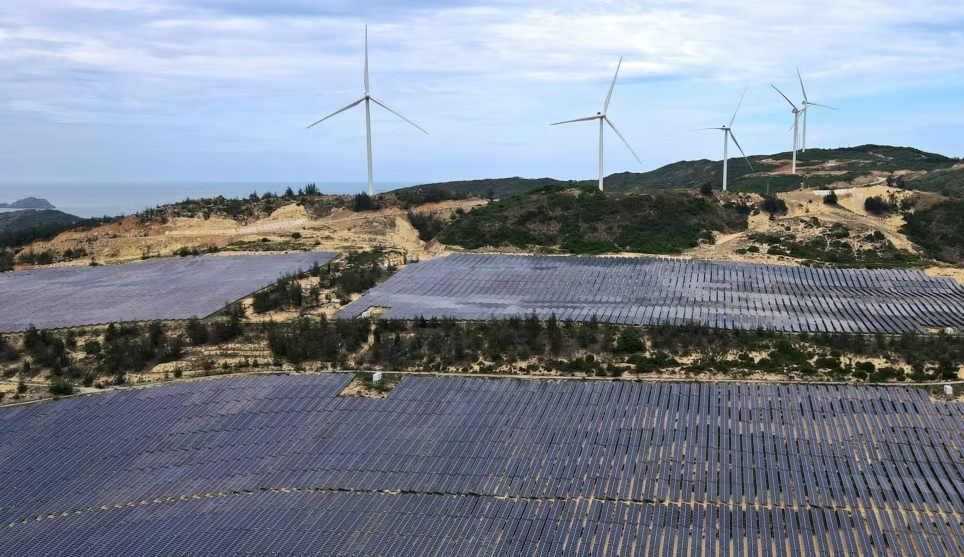
The goal is to speed the transition to renewable energy sources such as solar, wind and hydroelectric power by facilitating the transfer of energy from countries where there is a surplus to countries that need it.
In August, utility companies in Malaysia and Indonesia signed a memorandum of understanding to study 18 potential locations where cross-border transmission lines could be set up.
The deal, which comes in addition to power-trading deals among Laos, Malaysia, Thailand and Singapore, was signed on the sidelines of the 41st ASEAN Ministers on Energy Meeting held in conjunction with a regional energy business forum on August 24 in Bali, Indonesia.
Beni Suryadi, manager of power, fossil fuel, alternative energy and storage at the ASEAN Centre for Energy in Jakarta, Indonesia, said lines between countries are economically and technically feasible, and are supported by regional governments. Renewable energy "has become a crucial need for every country," he said.
Energy demand in the region grew by more than 80% between 2000 and 2019 and is expected to triple by 2050 from the 2020 level, according to a 2023 ASEAN-EU Business Council report.
The report stressed the urgency of transitioning to renewable energy, saying "increasingly severe weather, rising sea levels, and widespread tropical diseases all accompany climate change, to name a few scourges. There are estimates that climate change and its effects will wipe out 11% of ASEAN's GDP by 2100."
Dato' Indera Ir. Baharin, president and CEO of Malaysia's national utility company, called an interconnected ASEAN power grid "a critical step in the region's energy transition."
"A robust regional interconnection will allow for a wider reallocation of renewable energy resources that will help decarbonise the ASEAN power system," Baharin said in August. "It will help us to ensure the region's energy security … and transition to a cleaner, more sustainable future."
Darmawan Prasodjo, president director of Indonesia's state-owned utilities company, said, "We are about to enter a critical phase of transition energy that offers tremendous challenge but also magnificent opportunities."
“But,” he said, “we have to navigate the complexities of designing and building interconnected grids. Complexities of alignment of policy. Complexities of technical challenge. Complexities of commercial feasibilities. Complexities of large capital investment."
Peerapat Vithayarichareon, DNV principal consultant for energy systems in the Asia Pacific region, told The Jakarta Post that the expansion of clean energy in the region is being undermined by inadequate policy support and limited access to capital.
“Speaking from the technical perspective, there are concerns related to the potential impact of the cross-border power grid on the power systems within the countries," he said.
"Countries cannot just shift from coal-fired generation to renewable energy," he continued. "We need to prepare the system to accommodate the increasing share of wind and solar power generation, for example."
Ryan Wong and Lee Poh Onn, of ISEAS Yusof Ishak Institute, a think-tank headquartered in Singapore, wrote in February 2022 that there are doubts whether Southeast Asian governments recognize the benefits of harmonizing their energy grids and selling surplus energy.
“Southeast Asian countries are in general insular in their policy thinking. Therefore, it takes strong political will for them to look beyond national borders and immediate needs," they wrote.
Diverse energy options
Driving the energy-sharing idea is the fact that the ASEAN members — Brunei, Cambodia, Indonesia, Laos, Malaysia, Myanmar, the Philippines, Singapore, Thailand and Vietnam — have diverse sources of renewable energy.
Indonesia and the Philippines, for example, have substantial geothermal capacity. Laos and Malaysia have hydropower capacity. Vietnam has wind and solar capacity, and there is significant solar energy capacity in Thailand and Malaysia.
Laos has built more than 50 dams in the past 15 years, branding itself as the "battery of Southeast Asia." It already benefits from sales of power to Thailand, Vietnam and China.
A tiny nation with a population of 7.4 million, Laos has surplus power even after those sales. Singapore, a city-state of 6 million people, imports all its clean energy.
The ASEAN Interconnectivity Masterplan Study III, which began in 2019, first identified the 18 potential cross-border lines with an estimated capacity of up to 33 GW of electricity interconnections.
The Indonesia-Malaysia utility interconnection signed in Bali is an important step in enhancing the ASEAN power grid, but it isn't the first power-sharing agreement.
In 2017, Laos transmitted 100 megawatts of hydroelectric power to Malaysia through Thailand's grid, which was later increased to 300 megawatts.
Now, Singapore has joined the agreement in the Laos-Thailand-Malaysia-Singapore Power Integration Program. And Indonesia is developing a $5 billion plan to send power from solar energy to Singapore via undersea cables from facilities in Batam.
According to a September report by the Boston Consulting Group, developing the more ambitious ASEAN-wide grid will require regional funding mechanisms and fair financial settlements.
The participating nations must also agree on technical standards for inter-grid connections and ensure that the power transmission is reliable.
Tata Mustasya, energy and climate manager at Greenpeace Indonesia, said the ASEAN countries need to speed up their own energy transition and create smart grids at the national level before setting up ambitious targets to boost the use of renewable energy regionwide.
"Southeast Asian countries cannot achieve their zero-emission target without consistent and sufficient incentives for the clean and renewable energy and disincentives for fossil fuels," he told VOA Indonesian.